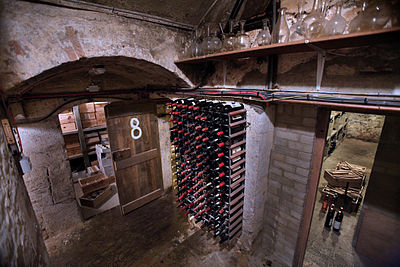Portal:University of Oxford
| Main page | Indices | Projects |
The University of Oxford portal
The University of Oxford is a collegiate research university in Oxford, England. There is evidence of teaching as early as 1096, making it the oldest university in the English-speaking world and the world's second-oldest university in continuous operation. It grew rapidly from 1167, when Henry II banned English students from attending the University of Paris. After disputes between students and Oxford townsfolk in 1209, some academics fled north-east to Cambridge where they established what became the University of Cambridge. The two English ancient universities share many common features and are jointly referred to as Oxbridge.
The University of Oxford is made up of thirty-nine semi-autonomous constituent colleges, four permanent private halls, and a range of academic departments which are organised into four divisions. Each college is a self-governing institution within the university, controlling its own membership and having its own internal structure and activities. All students are members of a college.
It does not have a main campus, but its buildings and facilities are scattered throughout the city centre. Undergraduate teaching at Oxford consists of lectures, small-group tutorials at the colleges and halls, seminars, laboratory work and occasionally further tutorials provided by the central university faculties and departments. Postgraduate teaching is provided in a predominantly centralised fashion.
Oxford operates the Ashmolean Museum, the world's oldest university museum; Oxford University Press, the largest university press in the world; and the largest academic library system nationwide. In the fiscal year ending 31 July 2023, the university had a total consolidated income of £2.92 billion, of which £789 million was from research grants and contracts.
Oxford has educated a wide range of notable alumni, including 30 prime ministers of the United Kingdom and many heads of state and government around the world. 73 Nobel Prize laureates, 4 Fields Medalists, and 6 Turing Award winners have matriculated, worked, or held visiting fellowships at the University of Oxford, while its alumni have won 160 Olympic medals. Oxford is the home of numerous scholarships, including the Rhodes Scholarship, one of the oldest international graduate scholarship programmes. (Full article...)
Selected article
The university's position of Keeper of the Archives dates from 1634, although its records pre-date this, and Oxford claims to have one of the longest continuous record-keeping traditions in Britain. Records were initially kept in the Priory of St Frideswide, moving to the University Church of St Mary the Virgin in the 14th century. The archives were left in considerable disarray by a burglary in 1544, and remained in chaos until Brian Twyne was appointed the first Keeper of the Archives in 1634 as a reward for his work preparing new statutes for the university. Under Twyne and his successor as Keeper (Gerard Langbaine), the archives were moved into one of the rooms in the Tower of the Five Orders in the Bodleian Library; three of the wooden presses that were built at that time to store them are still in use. The third to hold the position, John Wallis (pictured), prepared an index of the collection that was still used in the 20th century. (Full article...)
Selected biography
Selected college or hall
Wycliffe Hall is one of the Permanent Private Halls (PPHs) of the University of Oxford. Unlike the colleges, which are run by their Fellows, PPHs are run by an outside institution – in the case of Wycliffe Hall, the Church of England. Founded in 1877, it became a PPH in 1996. It provides theological training for candidates for ordained and lay ministry; it also admits other students to study theology. It is named after John Wycliffe, a 14th-century theologian, and its buildings are in North Oxford, on Banbury Road. It is rooted in the evangelical tradition of the Church of England, although it admits students from all Christian denominations. Its Victorian trust deed upholds the Thirty-Nine Articles, part of the English Reformation heritage of the Church of England, Since the 19th century the college has had close links with the Oxford Inter-Collegiate Christian Union and the Oxford Pastorate, two evangelical organisations working with Oxford students. Alumni include Donald Coggan (Archbishop of Canterbury), Tom Wright (Bishop of Durham), Nicky Gumbel (developer of the Alpha Course), and Wilbert Awdry (priest and creator of the Thomas the Tank stories). (Full article...)
Selected image

Did you know
Articles from Wikipedia's "Did You Know" archives about the university and people associated with it:
- ... that the statue of the Virgin and Child in the porch of the University Church of St Mary the Virgin (pictured) was cited as evidence in Archbishop Laud's execution trial, and has bullet holes made by Oliver Cromwell's troops?
- ... that the great-granddaughter of Mahatma Gandhi, Leela Gandhi, is a senior lecturer at La Trobe University in the English program?
- ... that British Conservative MP Richard Hornby unsuccessfully challenged former Prime Minister and Labour leader Clement Attlee before securing a safe seat?
- ... that cyber law author and professor Jonathan Zittrain co-founded StopBadware.org to distribute the task of collecting data about malware to Internet users at large?
- ... that the military theories of the 18th-century Welsh soldier Henry Lloyd were studied by George Washington and George S. Patton?
Selected quotation
Selected panorama
Wikimedia
The following Wikimedia Foundation sister projects provide more on this subject:
-
Commons
Free media repository -
Wikibooks
Free textbooks and manuals -
Wikidata
Free knowledge base -
Wikinews
Free-content news -
Wikiquote
Collection of quotations -
Wikisource
Free-content library -
Wikiversity
Free learning tools -
Wikivoyage
Free travel guide -
Wiktionary
Dictionary and thesaurus















